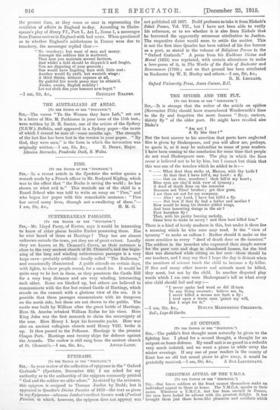SUBTERRANEAN PASSAGES.
[To TEE EDITOR OF THE " SPECTATOR."]
Sun,--Mr. Lloyd Parry, of Exeter, says it would be interesting to know of other places besides Exeter possessing these. Has ho ever heard of those at Hastings ? They too are almost unknown outside the town, yet they are of great extent. Locally they are known as St. Clement's Caves, as their entrance is close to the very ancient church of St. Clement's, and the begin- ning of the long and winding subterranean passages is a very large cave—probably artificial—locally called " The Ballroom," and occasionally illuminated. A guide attends on certain days, with lights, to show people round, for a small fee. It would be quite easy to be lost in them, as they penetrate the Castle Hill for a very long distance and are very winding, intersecting each other. Some are blocked up, but others are believed to communicate with the fine but ruined Castle of Hastings, which stands on the summit with a glorious view of the sea. It is possible that these passages communicate with its dungeons on the north aide, but these are not shown to the public. The castle was built by William after the great battle of Hastings. Here St. Anselm rebuked William Rufus for his vices. Here King John was the first monarch to claim the sovereignty of the seas. Here Henry I. kept his favourite yacht. Here was also an ancient collegiate church until Henry VIII. broke it up. It then passed to the Peihams. Hastings is the premier Cinque Port. Hastings sent twenty ships for defence against the Armada. The curfew is still rung from the ancient church
of St. Clement's.—I am, Sir, &c., ANGLO-LATIN.


































 Previous page
Previous page